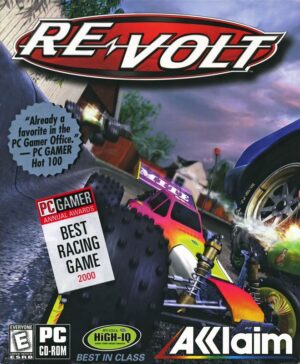Retro Replay Review
Gameplay
Die Hard Trilogy 2: Viva Las Vegas continues the formula of its predecessor by splitting action into three distinct gameplay styles: shootin’, drivin’, and runnin’ around. The shooting segments play like an on-rails light-gun shooter, where you blast through terrorist hordes in iconic Vegas locations. In driving levels, you pilot a souped-up police cruiser along the Strip, weaving through civilian traffic and performing high-speed maneuvers. The running levels shift to a third-person perspective, tasking you with exploration, puzzle-solving, and strategic use of cover as you navigate casino interiors and hotel backrooms.
Players can tackle these modes in Movie mode, which weaves brief story interludes between each gameplay type to give some context to John McClane’s mission, or in Arcade mode, which isolates each discipline into a focused run—complete with bonus challenge stages. Movie mode offers a sense of progression and narrative, while Arcade mode caters to those who want to master every shooting wave or racing segment back to back. Control responsiveness varies: the aiming reticule can feel jittery in hectic firefights, while the driving mechanics lean toward arcade simplicity, prioritizing drift and boost over realistic handling.
The balance among the three styles is uneven but enjoyable in bursts. The shooting stages capture the classic rail-shooter thrills, though enemy variety is limited, and ammo pickups become sparse at higher difficulties. Driving levels bring a welcome change of pace but suffer from occasional pop-in and a lack of branching routes. On-foot sections attempt to add stealth and exploration but sometimes feel tacked on, with basic puzzles and corridor layouts. Replayability is boosted by high-score leaderboards in Arcade mode and hidden collectibles, yet the absence of online functionality means bragging rights stay local.
Graphics
Visually, Viva Las Vegas leans into neon-soaked environments meant to evoke the glitz and glamor of the Strip. Casino floors are lined with bright carpets and slot machines, and exterior stages feature palm trees and illuminated marquees. However, low-resolution textures and draw-in are prevalent. Walls can appear flat at close range, and distant objects often pop into view abruptly, breaking immersion.
Character models and cutscene aesthetics are a mixed bag. McClane himself is recognizable by his signature white tank top, yet his facial features are blocky and express limited emotion. Enemy soldiers move with stiff, repetitive animations, and boss characters feel more like palette swaps than distinct villains. Cutscenes consist of brief FMV clips interspersed with static images and text, offering atmosphere but lacking polish.
Special effects such as muzzle flashes, skid marks, and explosive debris show off the hardware’s mid-90s capabilities. Nighttime lighting on the Strip emits a convincing glow, and reflective floors in casinos catch your peripheral movement. Still, these flourishes can’t entirely mask the dated polygon counts. Overall, the graphics hold nostalgic appeal but remind modern players of the era’s technical constraints.
Story
Die Hard Trilogy 2 doesn’t aim for a complex narrative—it simply drops John McClane into yet another terrorist crisis set against the backdrop of Las Vegas. The plot kicks off when a mysterious group dubbed “The Organization” threatens to detonate bombs across the city unless their demands are met. McClane, fresh off previous heroics, must race from casino to casino, defuse explosives, and bring the terrorists to justice.
Story delivery hinges on Movie mode, which strings together short cutscenes and on-screen text between levels. Dialogue is sparse, with McClane’s trademark quips reduced to one-liners, and supporting characters fleetingly appear in pixelated FMV. Arcade mode strips away narrative entirely, plunging you straight into action without context. Though the setup captures a basic Die Hard vibe, character development is virtually nonexistent, and plot twists feel perfunctory.
Despite its thin storyline, the game’s scenarios do evoke familiar filmic moments—bomb disposal tension, rooftop helicopter chases, and frantic hotel infiltration. Fans seeking a deeper narrative won’t find it here, but those drawn to McClane’s wisecracks and high-stakes showdowns may appreciate the premise as a mere excuse for varied gameplay. In the end, the story serves as a functional backdrop rather than a driving force.
Overall Experience
Die Hard Trilogy 2: Viva Las Vegas delivers a nostalgic, arcade-style package that caters primarily to fans of light-gun shooters and mid-90s action tangents. Its threefold gameplay structure offers variety, though each segment carries its own rough edges—shaky controls in shooting, simplistic driving tracks, and underdeveloped exploration stages. The game’s strengths lie in its brisk pacing and the novelty of switching between different modes, but longevity suffers once you’ve seen every neon corridor and defeated each boss.
Performance on original hardware is generally stable, but load times between levels can interrupt momentum, especially in Movie mode. Audio cues—gunshots, engine revs, and McClane’s gruff voiceover—help maintain a tense atmosphere, even when visual fidelity dips. For players who relish beat-’em-up arcade challenges or want a lightweight taste of the Die Hard license, there’s genuine fun to be had, particularly in short play sessions or cooperative “pass-the-gamepad” marathons.
In conclusion, ¡Viva Las Vegas! offers an entertaining, if uneven, slice of late-90s action gaming. It’s best approached with tempered expectations: embrace its arcade roots, enjoy the setting’s neon flair, and ignore the thin story beyond its basic setup. For a budget purchase or rental, it provides enough thrills to justify a spin, but those seeking a deeper narrative or modern production values may find it falls short of today’s standards. Fans of the first trilogy or collectors of vintage titles, however, will appreciate its idiosyncratic charms.
 Retro Replay Retro Replay gaming reviews, news, emulation, geek stuff and more!
Retro Replay Retro Replay gaming reviews, news, emulation, geek stuff and more!









Reviews
There are no reviews yet.